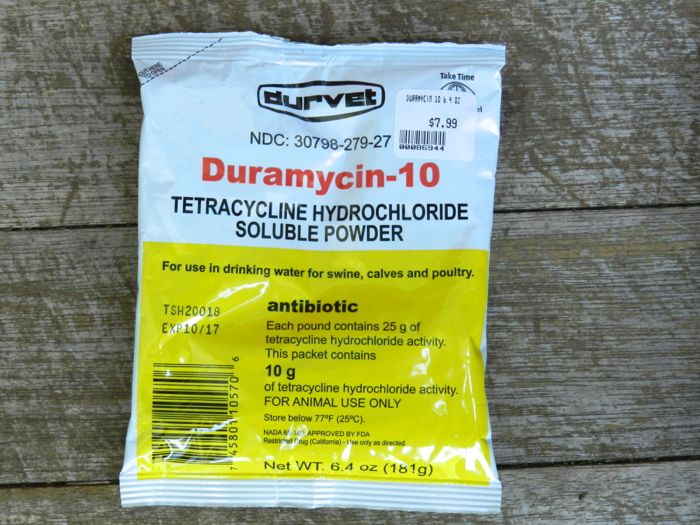When your flock comes down with a deadly respiratory ailment you need to treat them fast with something effective. Antibiotics can turn the tide and keep your chickens alive. But, these drugs can also be abused, and they have been, especially by high-volume “farms” that house animals in such unhealthy confines that they resort to putting antibiotics into the drinking water to keep their stock from dying. Bacteria multiply and mutate rapidly, and some will become immune to the medications. Feed antibiotics continuously and you’ll end up creating dangerous pathogens that are impervious to treatment. That has happened already, and to prevent a human health crisis now whole classes of antibiotics are illegal to give on a sub-therapeautic basis (this is a good thing.)
However, the drugs remain available for purchase, and can do much good when handled correctly. Some anitbiotics can only be had through veterinarians, but others can be purchased with ease at feed stores and on-line. Once in private hands, it’s up to the farmer to be careful with their use. The label might say, “for cattle and poultry” but the truth is that they are NOT legal for laying hens. The “for poultry” on the label is inexact – these drugs are approved only for meat and breeding stock, not layers. Backyard chicken keepers use them anyway to save our animals. But, because we use them “off-label” it means that there is little research done on how these drugs persist in the hen and in her eggs. There’s no research on how these drugs, manufactured for huge production facilities, should be appropriately dispensed to our own small flocks. One has to sort through science and trade publications, and then use common sense.
This last week I was grateful to have Duramcyin on-hand to treat my sick hens. No doubt some would have died if I had not dosed them with this antibiotic in the tetracycline family.
The first challenge is knowing how much to mix in water. The label recommends 200 to 400 mg per gallon of water. That wide range is not explained on the package or on the drug company’s website. And, most people don’t have mg measurers. I have a digital scale and calculated that 1/8 teaspoon per 16 fl. ounces (2 cups) is about right. That’s 1 teaspoon per gallon. Not much. After 24 hours, the Duramycin loses it’s efficacy. Every day the founts must be dumped out and filled with fresh antibiotics.
However, even when you get it mixed up properly, putting medication in the waterers will be no good if your hens, like mine, were too sick to drink.
For those chickens, I used a syringe to squirt the medicated water onto their tongues for them to swallow (directions here.) The problem is that the label doesn’t say how much each hen should drink of this antibiotic-laced water. A healthy hen can drink a cup or more of water daily. I can’t get that much in with a syringe. So, I mixed up 1/16 teaspoon Duramycin with a cup of water and dosed a few teaspoons over the course of the day with a syringe. By nightfall I saw marked improvement, so I knew that it was the right course.
Not all respiratory disease outbreaks can be resolved with Duramycin. Some require other antibiotics, and others are caused by viruses, which are unaffected by antibiotics. If there is no improvement in three days it is suggested that you stop the treatment and try something else. Tylan and Baytril are two other antibiotics that might work.
Then the question is: how long do you treat the hens? The package recommends “7 – 14 days.” That’s another wide range! If the hens are all fine by day 7 it is prudent to stop.
Hopefully, the hens survive and the big question beomes: when can you resume eating the eggs? The USDA has a website that farmers can rely on to check on drug withdrawal times. Although they can’t give out information for off-label usage, they have posted a review of the research of how long drug residues are seen in eggs after drug treatment has stopped. There’s a lot of data to wade through, and I did my best to come to a sensible course.
I’ve heard the concern that because the hen has all of her ova already in place, that drug exposure will contaminate her eggs for life. This is not the case. The germ is minute. It is the yolk that forms around that bit that absorbs the drugs. (Some chemicals are taken up more by the whites. It depends on the drug.) The yolk goes through about ten days of rapid growth before it is released by the ovary. This paper states: “Because of the protracted nature of egg development, many weeks may be required following treatment or exposure before eggs are free of drug residue.” The lab tests bear this out. Scientists varied the dosage and length of time that antibiotics were administered. In tests that compared somewhat to what my chickens were dosed with, their eggs were clear of residues by day 10. To be on the safe side, I’ll wait two weeks after my hens take their last drink of antibiotic water before eating their eggs.
While the hens are on medication, I’ll scramble up their eggs and feed them back to the chickens. They could use the boost from the eggs. Once off the meds, sadly, I will throw the eggs out. And then, two weeks later, I will be delighted to collect eggs and resume having two every morning for breakfast. Of course, by then, some hens will be going into the molt and eggs will be precious. When you raise your own, the egg supply is never steady!



Good Information! Thank you! When mime.came down with a respiratory infection, they had stopped distributing duramycin. And I had to resort.to another medication which was effective. But it can be difficult to give.a.chicken a pill…
Very good info. Thanks, Terry!
Agreed, great & through info as always….thanks you for being such a help. Hope the girls are continuing to improve & that your son is okay with taking care of the younger ones for the time being. Continued health & healing.
This information is another keeper! In particular the dosage information. Thanks Terry!
Excellent information, thank you. This has been such a harrowing time for you, and from what I’ve read, all of your online followers have been biting their nails with worry. I know I have. It’s amazing how attached one can become to someone else’s chickens! Speaking of which, you didn’t mention Miss Fluffy Britches (my lovey name for Pearl)–was she afflicted at all? I re-watch your YouTube video on calling chickens just so I can see Pearl. She is delightful. :-)
Miss Pearl had nary a sniffle, but this morning she was naked on her back and feathers everywhere. They’re coming off as if she’s molting. I’ve checked for feather mites and found none. I’m not sure yet if it’s a healthy molt or something else.
Thanks Terry for answering my questions tonight so quickly! Its nice to know I have a trusted site to turn to when something happens in my coop and I just cant sleep because I don’t know if I have done the right thing or missed something. I’m making notes right now on the Duramycin and terramycin so I have them set if something should occur. I don’t do very well when something seems wrong in my coop, so your site educates me and helps me be proactive. We’re all praying for your ladies.
I am so happy that your hens pulled through. Thanks for reviewing what worked for you and saved your hens. This info is invaluable.
I recently had a hen sounding like she had croup. I isolated her immediately and began the Duramycin. She was better the next day and since so I don’t know what it was i doubt if it was a respiratory problem since she would not have been completely better the next day. My question is once the package is open what is the best way to store it and for how long once it’s open? And if you start the antibiotic but realize u shouldnt have can you stop it? Thanks!
Good questions and just commonsense for answers. You did right to isolate. I would have stopped the antibiotics, too, if symptoms went totally away in under 24 hours. Once opened, I keep it in a zip plastic bag in a dry place. There’s a use-by date on the package, but no info about how quickly it breaks down if exposed to air. The drugs I used for this bout I’ve had for 1 year opened, and they worked.
Terry, I’m so glad that everyone has pulled through, and I’m so thankful to have your expertise in chicken keeping! I’ve copied your dosage suggestions and ordered the Duramycin to have on- hand. Thank you, thank you once again for everything you do!
Thank you for your scientific approach to learning as much as possible to safely and effictively treat the girls AND for sharing that wonderful knowledge with us! I’m so glad I found your blog…I look forward to reading it most every day!!!! My mixed flock of 12 gives me so much enjoyment! 4 Red sexlink, 4 buff orphington, 2 barred rock and an easter egger hens. 1 suprise to the group of chicks I got this spring….a beautiful Deleware rooster…so far he’s docile and has a beautiful voice…we’ll keep him as long as his manners hold out. The last rooster that we tried ran me out of the area by dropping one wing and charging at me every time I entered their domain. He moved in with my uncle and he fusses about him to this day… lol :)
We even added a bunny to our group about 6 months ago and it is a fabulous combo!!! Thumper is a soft, silly broken otter Rex and we love her!!!
Great job Terry!
Fortunately you have the pullets for eggs when the molts begin. Glad everyone is on the mend.
I agree with everything Laurie said. Just want to add my own thank you. Glad you’ve got through this trying time and did it with style. Not a hen lost. This is my “happy moment” for today so far. Your answer to Yemina will also be so helpful. Hope you have a great day!